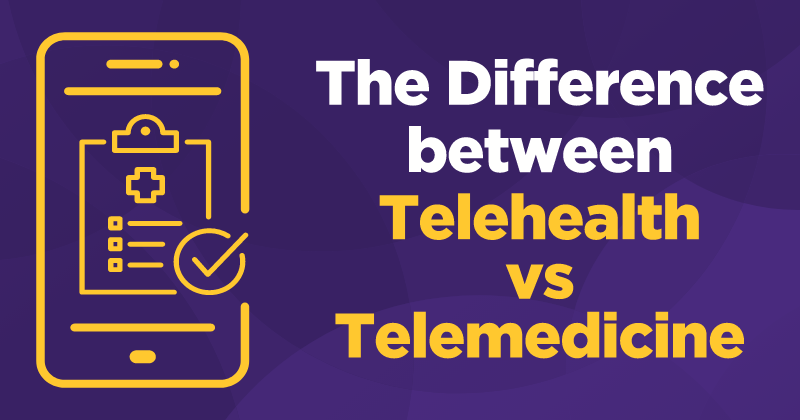The Difference between Telehealth vs Telemedicine

Remember when electric cars were considered futuristic? Now they’re common—on the road, in your neighbor’s driveway, maybe even charging in your own garage. It also wasn’t that long ago that virtual medical visits were considered futuristic, offered by only cutting-edge medical practices for their tech-savvy patients.
Today, as a result of the pandemic, providing the option of remote care is often considered a necessity. Policy changes1 have helped reduce obstacles to virtual visits, and it is now considered an efficient and effective way to deliver chronic, acute, primary and specialty care.
For practices that have the right tools in place and are using remote healthcare successfully, there may be no turning back. As technology continues to advance and patients begin to appreciate the convenience that virtual visits provide, we’ll likely see increasing demand from those who prefer to receive care from the comfort and safety of their homes. With the looming possibility of healthcare worker shortages, patients in rural areas may see the additional benefit of expanded care options. In fact, according to an article published by the National Center for Biotechnology Information2, 26 percent of Americans living in rural areas feel they do not have appropriate access to healthcare. Telemedicine can help change this.
Terms used to describe technology can be ambiguous, and healthcare is no exception. For example, while the terms “EMR” and “EHR” are used often interchangeably, there are distinctions between the two, just as there are differences between “telehealth” and “telemedicine.” While there is no universally agreed upon definitions of these terms, there is some commonality in the way they are typically described.
What is telehealth?
According to HealthIT.gov3, the Health Resources Services Administration defines telehealth as, “The use of electronic information and telecommunications technologies to support long-distance clinical health care, patient and professional health-related education, public health and health administration.”
Simply put, telehealth is a broad term that describes the use of technology to improve our healthcare delivery system and provide remote care, including nonclinical services.
Examples of telehealth include:
- Public health education, resources, alerts and updates
- Training and educating healthcare professionals
- Health administration and systems management
Telehealth can be delivered in a variety of ways including:
- Video Consults and Conferencing: Real-time, two-way interaction between patients and clinicians, or the broadcast of a training session for healthcare providers
- Remote Patient Monitoring (RPM) or Remote Health Monitoring: Information technology to gather and transmit patient health data (such as glucose levels, cardiac monitoring, blood pressure and blood oxygen readings) in a nontraditional healthcare setting
- Mobile Health: Health information delivered over mobile devices like tablets and smartphones, including texting patient instructions prior to surgery
- Asynchronous Services: Transmission of medical reports that does not require real-time interaction between patients and clinicians
Telehealth is a broad term that encompasses telemedicine. Telehealth includes remote nonclinical services, while telemedicine refers specifically to remote clinical services.
What is telemedicine?
Telemedicine is a subset of telehealth but refers specifically to the delivery of remote clinical services. Telemedicine is often used for prescription management, follow-up visits, management of chronic conditions, and a variety of other clinical services that are delivered remotely through secure audio and video connections. Beyond the added convenience it offers patients, according to the CDC4, the benefits of telemedicine include helping to reduce hospital readmission rates, providing nonemergent care to long-term care facility residents, and increasing access to specialists. Examples of telemedicine include:
- Remote Video Conference Consultations: Used to diagnose, treat and prevent diseases or injuries
- Post-Op Follow-Up Visit: Conducted through text message, phone call or video conference
- Monitoring: Used to support a patient’s health condition post-surgery or after therapy
- Post-Op Transmission of Vitals: Including blood pressure data, heart monitoring and glucose levels
- Remote Chronic-Care Management: Virtual care visits to monitor the health of chronic-care patients Preventive Care Support: Remote health visits to help patients live healthier, longer lives
Now that we’ve discussed the differences between telehealth and telemedicine, test your knowledge by taking this short quiz.
Telehealth vs Telemedicine: True or False?
All telemedicine is telehealth. But not all telehealth is telemedicine.
True
Telehealth can include remote nonclinical services, including public health education services and instruction to medical students, while telemedicine refers to remote clinical services.
All mobile health services are telemedicine.
False
A public health alert is considered telehealth. But providing your patient with post-op instructions is considered telemedicine.
All videoconferencing is telemedicine.
False
A video conference between a medical instructor and students is considered telehealth since it’s nonclinical. However, a video consult between a patient and a healthcare provider is considered telemedicine because it involves a clinical relationship that helps provide care.
Not all asynchronous medical services are telemedicine.
True
While a health publication created for educational purposes is considered telehealth, digitally sharing a patient’s X-ray is considered telemedicine.
Telemedicine is here to stay. So, if your patients aren’t already demanding remote visits, chances are they will be soon.
1Health Resources & Services Administration: HIPAA Flexibility for Telehealth Technology, January 28, 2021
2National Center for Biotechnology Information: Telemedicine, the Current COVID-19 Pandemic and the Future: A Narrative Review and Perspectives Moving Forward in the USA, August 18, 2020
3HealthIt.gov: What is telehealth? How is Telehealth Different from Telemedicine?, October 17, 2019
4Centers for Disease Control and Prevention: Using Telehealth to Expand Access to Essential Health Services during the COVID-19 Pandemic, June 10, 2020